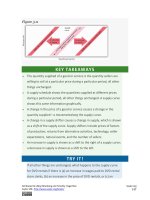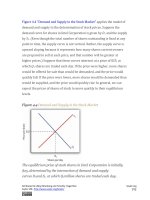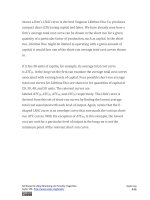Authors libby rittenberg 61
Bạn đang xem bản rút gọn của tài liệu. Xem và tải ngay bản đầy đủ của tài liệu tại đây (291.29 KB, 1 trang )
drilling foremen steer them by monitoring them on computer screens from
the comfort of Mars. “We don’t hit as many dry holes,” commented Shell
manager Miles Barrett. As a result of these new technologies, over the past
two decades, the cost of discovering a barrel of oil dropped from $20 to
under $5. And the technologies continue to improve. Three-dimensional
surveys are being replaced with four-dimensional ones that allow
geologists to see how the oil fields change over time.
The Mars project was destroyed by Hurricane Katrina in 2005. Royal
Dutch Shell completed repairs in 2006—at a cost of $200 million. But, the
facility is again pumping 130,000 barrels of oil per day and 150 million
cubic feet of natural gas—the energy equivalent of an additional 26,000
barrels of oil.
Technology is doing more than helping energy companies track oil
deposits. It is changing the way soft drinks and other grocery items are
delivered to retail stores. For example, when a PepsiCo delivery driver
arrives at a 7-Eleven, the driver keys into a handheld computer the
inventory of soft drinks, chips, and other PepsiCo products. The
information is transmitted to a main computer at the warehouse that
begins processing the next order for that store. The result is that the driver
can visit more stores in a day and PepsiCo can cover a given territory with
fewer drivers and trucks.
New technology is even helping to produce more milk from cows. Ed
Larsen, who owns a 1,200-cow dairy farm in Wisconsin, never gets up
before dawn to milk the cows, the way he did as a boy. Rather, the cows
are hooked up to electronic milkers. Computers measure each cow’s
output, and cows producing little milk are sent to a “hospital wing” for
Attributed to Libby Rittenberg and Timothy Tregarthen
Saylor URL: />
Saylor.org
61









